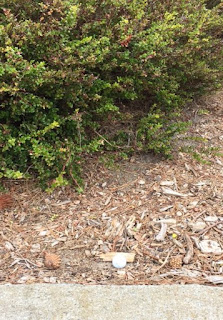This happened
last week at the par five 10th hole on Poppy Hills last week during
an NCGA Championship.
The player’s
ball is not on the cart path, but his stance would be, so he would be entitled
to relief under Rule 24-2. His nearest
point of full relief, however, would be squarely in the middle of the big bush
on the other side of the ball. A club
length from that point would have left him still in the bush. So, if he took relief, he would be in the
position of having to then take relief again under Rule 28, Ball Unplayable,
which of course would mean a penalty stroke.
He did the
smart thing, and played the ball back to the fairway from where it lay. He was still in position to hit the green in
regulation.
A few groups
later a player hit his ball well right of this spot into some deeper
trouble. He played a provisional right
down the middle of the fairway. I
started searching before he arrived, but not very hard. When he got to me, we looked for a few
seconds, and he asked, “I don’t have to look for this, do I?” The answer is of course no. If we had found the ball, the provisional
would no longer be an option, and if he was in an unplayable situation, and he
couldn’t find relief within two club-lengths or on a straight line to the
flagstick, he would have to go back to the tee.
Since he already had a provisional in the middle of the fairway, we
discontinued the search.
This is
pretty much what happened in 2001 at Torrey Pines, when Phil Mickelson and
Frank Lickliter both hit their tee shots into a canyon during the playoff. They hit provisional balls, but before they
could proceed a marshal found both balls, negating the provisionals. Mickelson famously said, "He
[the spotter] was just doing his job. I just wish he didn't do it so
effectively. I had just hit a perfect drive before. I didn't want to walk back
and hit another one."
Incidentally,
later this exact thing happened. Again,
I started searching but not very hard.
The player took a quick look, and was about to give up on his original
and go play his provisional when his partner found his ball in the middle of a
big bush. He wasn’t very pleased when I
informed him that he had to go back to the tee rather than play his
provisional. See Decision 27-2c/2.
P.S. Don’t miss it right on Poppy Hills #10.

